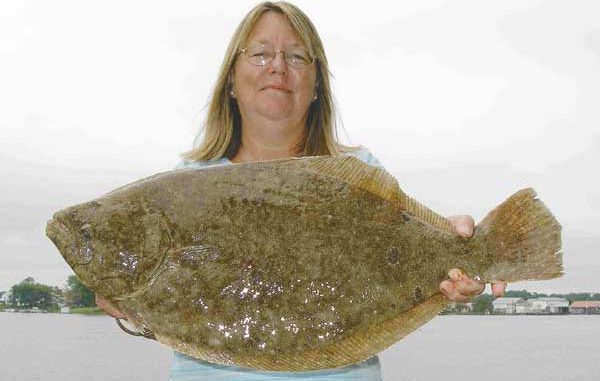
Brunswick County anglers get their good chance at doormats during late spring.
When the water temperature breaks the mid-60s mark at the N.C. coast, inshore anglers start to get an itch that makes them spend all weekend on a skiff with nothing but a sandwich, a bucket of minnows, a few cold beers, and an outboard engine chugging along at its lowest speed.
This time of year brings anglers to the water, hoping to do some flounder pounding for doormat slabs.
“About the first of May is when it gets going,” said Eddie O’Briant, a Brunswick County flounder angler for more than 40 years. “The fish really don’t do much biting until the water hits 65 degrees,”
Although he currently doesn’t guide because of health reasons, O’Briant is a seasoned pro and flounder-fishing authority. He has competed in Brunswick County tournaments and shared a boat with some of North Carolina’s most renowned flatfish experts, including Daught Tripp and Jimmy Price.
“The big fish come in at the end of May,” O’Briant said. “We’re talking 9 pounds.“
Early in the year O’Briant prefers mud minnows as his bait of choice for flounder.
“I like those big fat mud minnows, but even pinfish or little croaker work fine,” he said.
Although O’Briant said he wasn’t quite sure why, Tubbs Inlet is where flounder always seem to start biting first at the southeastern N.C. coast. Before the water becomes fully warmed and before flounder have had a chance to penetrate the Intracoastal Waterway, they can be caught at Tubbs.
“The early bite this year will be at Tubbs Inlet,” he said. “It always is.”
However, Tubbs Inlet can be tricky to navigate, and it’s not advisable to try to approach it from the ocean side. The shoals make broaching Tubbs Inlet from the ocean a treacherous, if not impossible, task. Anglers instead should reach the inlet from the smoother and deeper Intracoastal Waterway.
If traveling south, from the Ocean Isle Bridge they should go almost completely to the Sunset Beach Bridge then take Jinks Creek to the left to access Tubbs Inlet. The water is fairly deep there, and boats with a deeper draft can even access via Jinks Creek. But O’Briant still advised anglers to be mindful of the tide.
“They should come on the latter part of the rising tide and leave before the tide has retreated too far,” he said.
Even if the water temperature remains a little cool (not likely during June but possible during late May), a good early flounder bite still may exist. That’s because inland water that rushes toward the ocean during falling tides is warmer and also carries lots of flatfish food.
So O’Briant said he waits until the tide starts to recede to try fishing for flounder at Tubbs Inlet. He has been on the water when the surface temperature was 62 degrees, then rose to 67 degrees after the change of tide.
Some areas near shallow flats or at flats with dark mud (which absorb the sun’s rays more effectively) feature warmer water, and that difference in temperature is enough to make flounder become active feeders.
Randy Niebauer, a regular at Tubbs Inlet, especially during the early summer, slow trolls using his trolling motor for flounder and employs a double-hook fish-finder rig.
His skiff is outfitted with two trolling motors, one on either trim tab. The motors are strong enough to pull the boat slowly and quietly even in a stout current.
“ ‘Rodney’ is the best fisherman on the boat,” Niebauer said (referring to his fishing rods).
Niebauer uses medium to medium-light action rods set in rod-holders. When a fish bites, the soft backbone of the rods give flounder a chance to take baits.
A fish often gets hooked before an angler can touch a rod — earning “Rodney” his flounder-catching reputation.
Flounder rigs
Niebauer and O’Briant use hooks that are fairly pliant (such as gold Aberdeen light wire hooks).
The theory is if a hook snags an oyster shell or rock, the entire rig won’t be lost. Instead, the hook straightens and later can be bent back into the proper position, then impaled through another bait, and it’s ready to fish, good as new.
One unique aspect of O’Briant’s rig is he uses a Lindy no-snag weight (often used for walleye fishing). This weight softly “walks” across bottoms, avoids snags well and isn’t very invasive, so it doesn’t spook fish easily.
Although his use of 20-pound-test line might seem like overkill, O’Briant prefers stout monofilament when he fishes for flounder. He said because of all the shells the line comes into contact with, it doesn’t take long before 20-pound test is worn down to 15-pound test.
“The rougher the bottom is, the closer you have to keep the rig to the boat,” he said.
The more line that’s spooled off a reel during trolling or a drift, the more chances of snagging something other than a flounder. He also uses between 10 and 30 inches of fluorocarbon leader, depending upon the structure and snag possibilities at a particular stretch of bottom.
Common mistakes
O’Briant doesn’t subscribe to the commonly-held theory that flounder scale baitfish before eating them. Instead, he thinks anglers snatching a baitfish away from a flounder and through its teeth are what really “scale” a minnow.
“A bass fisherman has a lot of trouble catching a flounder,” he said, laughing at the memory. “I took a bass fisherman and his wife on a charter one time. He caught three (flounder) and his wife caught nine.”
The normal tactic for catching bass is to make a quick and hard hookset as soon as the angler feels a bite — exactly the opposite technique one should use for flatfish.
O’Briant said a flounder isn’t going to release a bait easily once it’s got it in its mouth. He said he’d rather give the fish too much time than too little time before setting the hook.
In fact, when fishing for flounder at docks, O’Briant said he applies easy pressure with his rod to pull fish out from underneath a dock so when he does set the hook, the flounder is away from the structure and less likely to break him off on a piling.
When it’s time to set the hook, O’Briant sweeps the rod in a relatively slow, steady motion, with the rod parallel to the water.
Take it easy
A loose drag also is necessary for fighting flounder.
Flounder are known for throwing hooks, so giving a hooked fish the ability to pull line against drag pressure increases the chances of a successful catch.
Also, it’s important to keep the flounder’s head under water when it’s reeled to a boat.
O’Briant said anglers should keep their rod tips close to the water, not above their heads. Keeping a bend in the rod and constant pressure on a flounder is essential to successfully landing fish.
Slow trolls work best
Anglers who troll for flatfish should go as slowly as possible.
O’Briant uses a trolling plate mounted behind his prop to slow his troll to about one-half mile per hour, and that’s how he catches big flounder.
“The guys who win the tournaments may only catch one or two fish a day,” he said. “The guys you see cruising along, you won’t see them catch a real big fish, hardly ever.“
Obviously, because flounder are “lie-in-wait-and-ambush” fish, O’Briant’s analysis makes sense — flounder won’t chase baits for long distances.
Move upstream
Ever heard that anglers need to troll down current because if a baitfish approaches a flounder from the rear, that bait will spook the fish?
O’Briant doesn’t buy it; he trolls against the current.
An advantage of the Lindy weight is that it’s light and bounces lightly on the bottom.
“It’s no more than a shell washing across (a flounder),” O’briant said. “I’ve had them hit the weight then hit the bait.“
Fish the shells
In some ways, the Atlantic Ocean is no different than any other public water. Many of the best spots are ones that few other people fish.
Areas that are thick with oysters are among some of the best places for larger flounder.
Using a lighter weight can avoid snags while allowing anglers to reach the fish that others miss.
Some flounder anglers claim because a flat fish lies on the bottom and covers itself with sand for camouflage, flounder generally avoid uneven, prickly oyster shell beds.
O’Briant also disagrees with that theory.
“You’ll catch (a flounder), and it’ll have spots and scratches all over it because it’s been lying on shells,” he said.
Where to go
During early May, Tubbs Inlet is generally the place to be, but during mid-to-late summer months, the water gets hot so the flounder go deeper into estuarine waters.
Since the finger mullet are so plentiful during this time, O’Briant likes to switch from mud minnows to finger mullets.
Inshore, he recommends fishing water anywhere from 3 to 17 feet in depth. Of course, heavy current and breaks from that current are key habitats to find doormats.
Just like freshwater trout, flounder are looking to be as close as possible to as much moving water as possible, while putting forth the least amount of effort to remain at a favorite spot.
The back sides of ridges and sand bars are key flounder-holding areas.
It’s also wise to keep up to date with the fishing successes or failures of local watermen. A call to fish houses or a tackle shop to find out if the shrimpers are making trips often can give an important clue.
If shrimpers are active, then shrimp are being de-headed at the docks with byproducts tossed over the sides at those docks. Flounder love to eat shrimp heads but also will feast on the baitfish and small crabs attracted to shrimp-boat docks.
Such shrimp-boat areas can be found at the Shallotte River.
In fact, O’Briant once caught 79 flounder a couple hundred yards up the Shallotte River.
Near Holden Beach is the mouth of the Lockwood Folly River. O’Briant said he estimates 80 percent of flounder tournaments in the Brunswick County area are won at the mouth of this river.
It has a wall against which large flounder find deeper water and swift currents.
Anglers who travel up Lockwood Folly River also may be rewarded with a limit of doormats. Good numbers of flounder usually are available upstream.
O’Briant said he likes to fish upriver to near Varnamtown.
He pulls two lines with his rods set in holders, one on either side of boat, with the rods angled parallel to the water to keep enough distance between his lines to avoid tangles.
Unless the bottom structure is too dense, he uses two hooks on each line, with one leader shorter than the other so the minnows don’t get tangled.
In the early season, nearshore wrecks are great places to find flounder. Just about any type of minnow or cut bait will draw a strike from these fish.
Flounder that live at the wrecks are ready to bulk up for the warm-water season. So stationary bottom fishing works well, and other non-target species may fill an angler’s time while he waits for a flounder to find his baits.
Many anglers drift baits using a Carolina rig with 1 to 3 ounces of weight (depending upon the strength of the current). They fish the edges of the reefs to avoid continual snags, while keeping the bait on the bottom in the strike zone.
Anglers who fish inlets should begin near to the ocean and even at reefs to hook up with flounder.
As the water warms, the fish make a move inshore. As the summer progresses, anglers should spend time navigating and investigating inshore waters.
Finding deeper holes, especially those with current, and fishing them slowly, rolling a Carolina rig down them, or trolling slowly with a Lindy no-snag weight are good techniques to catch inshore flatfish.
Anglers should use mud minnows early in the spring then switch to pinfish, menhaden and mullet as the water gets hotter.
Although some experts such as Jimmy Price can catch flounder with artificial lures, for the rest of us live bait works best. And remember to ease up on the drag to have the best chance to put a doormat in your cooler.

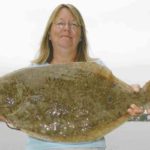
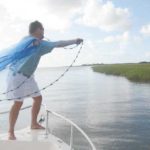

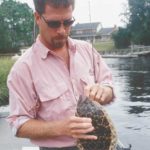
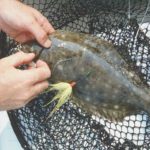

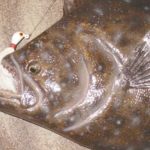
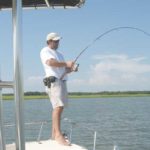


Be the first to comment